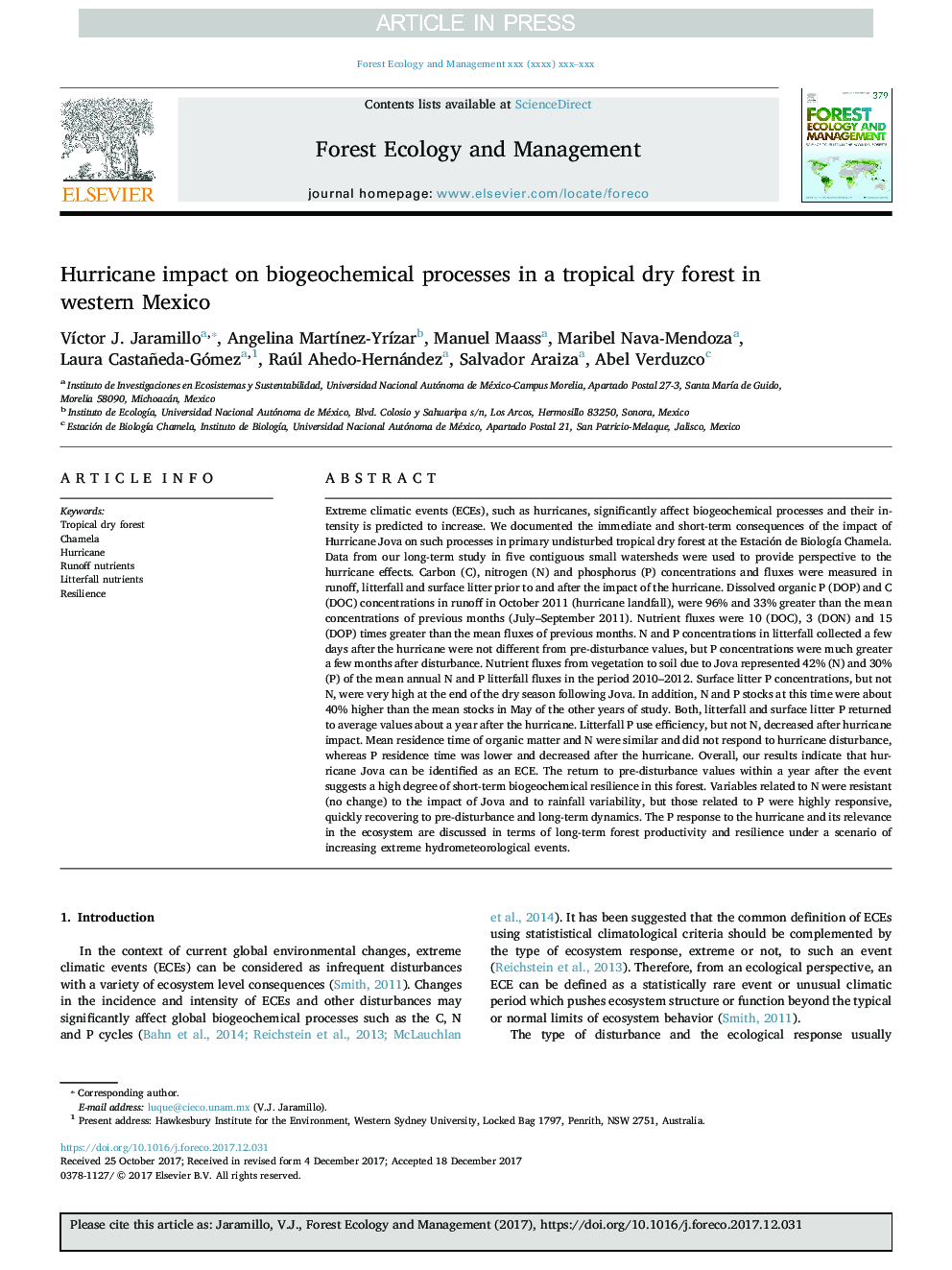| کد مقاله | کد نشریه | سال انتشار | مقاله انگلیسی | نسخه تمام متن |
|---|---|---|---|---|
| 6541544 | 1421334 | 2018 | 9 صفحه PDF | دانلود رایگان |
عنوان انگلیسی مقاله ISI
Hurricane impact on biogeochemical processes in a tropical dry forest in western Mexico
ترجمه فارسی عنوان
تاثیر طوفان بر فرآیندهای بیوگرافی و شیمی در یک جنگل خشک گرمسیری در غرب مکزیک
دانلود مقاله + سفارش ترجمه
دانلود مقاله ISI انگلیسی
رایگان برای ایرانیان
کلمات کلیدی
جنگل خشک گرمسیری، چاملا، طوفان، مواد مغذی روان مواد مغذی آهک انعطاف پذیری،
موضوعات مرتبط
علوم زیستی و بیوفناوری
علوم کشاورزی و بیولوژیک
بوم شناسی، تکامل، رفتار و سامانه شناسی
چکیده انگلیسی
Extreme climatic events (ECEs), such as hurricanes, significantly affect biogeochemical processes and their intensity is predicted to increase. We documented the immediate and short-term consequences of the impact of Hurricane Jova on such processes in primary undisturbed tropical dry forest at the Estación de BiologÃa Chamela. Data from our long-term study in five contiguous small watersheds were used to provide perspective to the hurricane effects. Carbon (C), nitrogen (N) and phosphorus (P) concentrations and fluxes were measured in runoff, litterfall and surface litter prior to and after the impact of the hurricane. Dissolved organic P (DOP) and C (DOC) concentrations in runoff in October 2011 (hurricane landfall), were 96% and 33% greater than the mean concentrations of previous months (July-September 2011). Nutrient fluxes were 10 (DOC), 3 (DON) and 15 (DOP) times greater than the mean fluxes of previous months. N and P concentrations in litterfall collected a few days after the hurricane were not different from pre-disturbance values, but P concentrations were much greater a few months after disturbance. Nutrient fluxes from vegetation to soil due to Jova represented 42% (N) and 30% (P) of the mean annual N and P litterfall fluxes in the period 2010-2012. Surface litter P concentrations, but not N, were very high at the end of the dry season following Jova. In addition, N and P stocks at this time were about 40% higher than the mean stocks in May of the other years of study. Both, litterfall and surface litter P returned to average values about a year after the hurricane. Litterfall P use efficiency, but not N, decreased after hurricane impact. Mean residence time of organic matter and N were similar and did not respond to hurricane disturbance, whereas P residence time was lower and decreased after the hurricane. Overall, our results indicate that hurricane Jova can be identified as an ECE. The return to pre-disturbance values within a year after the event suggests a high degree of short-term biogeochemical resilience in this forest. Variables related to N were resistant (no change) to the impact of Jova and to rainfall variability, but those related to P were highly responsive, quickly recovering to pre-disturbance and long-term dynamics. The P response to the hurricane and its relevance in the ecosystem are discussed in terms of long-term forest productivity and resilience under a scenario of increasing extreme hydrometeorological events.
ناشر
Database: Elsevier - ScienceDirect (ساینس دایرکت)
Journal: Forest Ecology and Management - Volume 426, 15 October 2018, Pages 72-80
Journal: Forest Ecology and Management - Volume 426, 15 October 2018, Pages 72-80
نویسندگان
VÃctor J. Jaramillo, Angelina MartÃnez-YrÃzar, Manuel Maass, Maribel Nava-Mendoza, Laura Castañeda-Gómez, Raúl Ahedo-Hernández, Salvador Araiza, Abel Verduzco,
